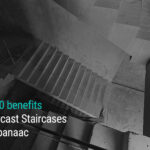Eco-friendly construction is the need of the hour.
The Construction industry is one of the most booming industries, but at the same time, a heavy consumer of natural resources and harms the environment. But as we grew, the industry started to realize the heavy toll it put on the planet. Thus a need has arisen for the construction industry to practice more eco-friendly practices to conserve and reduce the environmental impact. It’s the need of the hour to be aware of the environmental effects and how we can decrease them by using eco-friendly materials and techniques. Some principles cover sustainable construction. We, at Urbanaac, are constantly monitoring trends such as Sustainable Design, Durability, Sustainable building materials, and Water Conservation to help make the.
Sustainable Construction uses renewable and recyclable materials when building new structures and reduces energy consumption and waste. The primary goal of sustainable construction is to reduce the industry’s environmental impact. However, the large equipment utilized in development depends vigorously on petroleum products, and, surprisingly, wasteful power use can bring about the superfluous torching of petroleum derivatives further the energy supply line.
Many organizations have started to regulate and laud the design and construction of ecofriendly structures; some of the global certifications include LEED (Leadership in Energy and Environmental Design) and GRIHA (Green Rating for Integrated Habitat Assessment). The energy consumption and overall green performance of the buildings are also regulated by these organizations.
Making construction more eco-friendly (and how we can do it)
Use of Sustainable Construction materials:
Due to the environmental crisis, there has been a surge in the use of sustainable materials in the construction industry. Locally available materials like adobe, mud, bamboo, and use of recycled materials are some of the materials that can be easily used in the form of bricks and structural elements. These materials with proper construction techniques are alternatives and often work better than conventional construction materials.
Bamboo, Stone, Eco-friendly wood, Recycled and natural materials, and Earthen structures all are basic materials that are used as construction materials. Eco-friendly wood can be used as a construction material in various ways, such as engineered wood, reclaimed wood, and certified wood which are highly preferred for green building. Reclaimed wood can be found in places like retired barns, salvage yards, shipping crates, pallets, home remodeling companies, etc. These woods can be treated by several methods to improve their durability and longevity of eco-friendly wood.
Bamboo, an eco-friendly construction material, can almost be used for all structural components of a house, from floors to beams, due to its durability. It also adds the strength of wood and aesthetics. Stones can be used for buildings, not to produce harmful chemicals and toxins. They are low maintenance cost and have excellent green properties that make them suitable for harsh conditions. Many materials like plastic, vinyl, rubber, scrap steel, etc., can be recycled and used as eco-friendly house construction materials directly or by creating composites. They have better longevity and low maintenance costs.
Construction techniques:
Adopting sustainable construction methods will reduce the organization’s impact on the environment. But there are more tangible benefits, too which will help the firms demonstrate the value of sustainable construction beyond environmental concerns. Architectural firms have started using an amalgamation of indigenous and modern sustainable construction techniques. There has been a shift in the need for vernacular architecture, which respects the environmental and cultural setting of the site and context, unlike the modernist approach, which advocated the use of steel, cement, and concrete.
Precast Technology:
At Urbanaac, we are committed to making construction more eco-friendly and aligned with our sustainability goals. Our precast technology elements help reduce noise pollution on construction sites. Moreover, it reduces air pollution in residential areas. Lastly, we ensure minimal wastage of construction materials. Team Urbanaac is dedicated to working towards a sustainable construction industry and is actively devising solutions that will help us get there!
Closure:
Infrastructure should be built to deliver good indoor air quality through ventilation and avoid using materials and chemicals that create harmful or toxic emissions. Natural ventilation could decrease energy consumption, especially in the residential sector. Various innovations in construction advocate sustainable construction systems, and making construction more eco-friendly is a beneficiary step for the industry. At Urbanaac, we are proud of creating solutions that reduce dust as well as noise pollution through industry-made precast technology solutions which also help accelerate the project development process!








